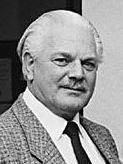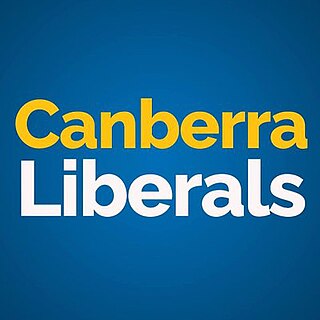Related Research Articles
The premiers and chief ministers of the Australian states and territories are the heads of the executive governments in the six states and two self-governing territories of Australia. They perform the same function at the state and territory level as the Prime Minister of Australia performs at the national level. The King of Australia and the state governors are the formal repositories of executive power; however, in practice they act only on the advice of state premiers and ministers except in extreme circumstances, such as a constitutional crisis.

Gary John Joseph Humphries is a Deputy President of the Administrative Appeals Tribunal. He was a member of the Australian Senate representing the Australian Capital Territory for the Liberal Party of Australia from 2003 to 2013. He was the Chief Minister of the Australian Capital Territory from 2000 to 2001; and was elected to the first parliament of the Australian Capital Territory, in 1989, later representing the Molonglo electorate until 2003.

The Legislative Assembly for the Australian Capital Territory is the unicameral legislature of the Australian Capital Territory (ACT). It sits in the Legislative Assembly Building on Civic Square, close to the centre of the city of Canberra.
Rosemary Follett is a former Australian politician who was the inaugural Chief Minister of the Australian Capital Territory, serving in 1989 and again between 1991 and 1995. She was the first woman to become head of government in an Australian state or territory.
The Leader of the Opposition of the Australian Capital Territory, is an official role usually occupied by the leader of the second largest party or coalition in the Australian Capital Territory Legislative Assembly. The title is conferred under Standing Order 5A of the ACT Legislative Assembly, that the Leader of the Opposition shall be the leader of the largest non-Government party, with the consent of that member. In the event of an equal number of members of the second largest party, the Assembly shall vote and elect a Leader of the Opposition.
Residents Rally was an Australian political party, with four candidates elected to the first Australian Capital Territory Legislative Assembly at the 1989 Australian Capital Territory general election. Residents Rally were led by Canberra human rights barrister and lawyer, Bernard Collaery. Collaery defined the party as "a community-based urban green party". The Rally formed a coalition with the Liberal Party, led by Trevor Kaine, in late 1989. However, this fractious Alliance was to last for only two years before collapsing. The Rally was unsuccessful in retaining any seats at the 1992 ACT general election.
The Independents Group were a short-lived Australian political party operating in the Australian Capital Territory. They briefly served as part of the Alliance government, alongside the Liberal Party and Residents Rally.

Trevor Thomas Kaine, was an Australian politician who served as Chief Minister of the Australian Capital Territory from 1989 to 1991. Kaine was elected into a multi-member single electorate in the unicameral Australian Capital Territory Legislative Assembly, from 1989 to 2001, initially as a member of the Liberal Party and later as an independent.
Elections to the Australian Capital Territory Legislative Assembly were held on Saturday, 4 March 1989. This was the first direct election by voters in the Australian Capital Territory (ACT) for their own legislative body.
Wayne Bruce Berry, former Australian politician, was a member of the unicameral Australian Capital Territory Legislative Assembly from 1989 to 2008, representing the electorate of Ginninderra for the Labor Party. Berry served as Deputy Chief Minister from 1991 to 1994, Leader of the Opposition from 1997 to 1998 and Speaker of the Assembly from 2001 to 2008.

The Government of the Australian Capital Territory, also referred to as the Australian Capital Territory Government or ACT Government, is the executive authority of the Australian Capital Territory, one of the territories of Australia. The leader of the party or coalition with the confidence of the Australian Capital Territory Legislative Assembly forms Government. Unlike the Australian States and the Northern Territory, the Australian Capital Territory Legislative Assembly directly elects one of their number to be the Chief Minister of the Australian Capital Territory as the head of the Government, rather than being appointed by a Governor or Administrator.
The Australian Capital Territory House of Assembly was the main elected representative body of the Australian Capital Territory between 1975 and 1986, when preparations began to be made for the granting of self-government to the Territory. It served a largely advisory role, with most powers over the Territory still lying in the hands of the relevant federal minister through the life of the Assembly.

The chief minister of the Australian Capital Territory is the head of government of the Australian Capital Territory. The leader of the party with the largest number of seats in the unicameral Australian Capital Territory Legislative Assembly usually takes on the role. Unlike other states and territories, the chief minister is not appointed by a governor or administrator, but elected directly by the Assembly.

Bernard Joseph Edward Collaery is an Australian barrister, lawyer and former politician. Collaery was a member of the Australian Capital Territory's first Legislative Assembly for the Residents Rally party, from 1989 to 1992. He served as Deputy Chief Minister and Attorney-General from 1989 to 1991 in the Kaine Alliance Government.
Ellnor Judith Grassby, néeLouez, a former Australian politician, was a member of the multi-member single constituency unicameral Australian Capital Territory Legislative Assembly, representing the Labor Party between 1989 and 1995. Grassby served as Minister for Housing and Urban Services in the First Follett Ministry.
David John Prowse, a former Australian politician, was the first Speaker of the Australian Capital Territory Legislative Assembly, serving between 1989 and 1992. Elected at the 1989 general election to the inaugural multi-member single electorate unicameral Australian Capital Territory Legislative Assembly representing, initially, the No Self-Government Party, Prowse then sat as an independent, before joining the Liberal Party.
The First Follett Ministry was the first ministry of the Government of the Australian Capital Territory, and was led by Labor Chief Minister Rosemary Follett and her deputy, Paul Whalan. It was sworn in on 16 May 1989, after the 1989 election when a hung parliament was the outcome. Labor, with a plurality of seats, led a minority government in the Australian Capital Territory Legislative Assembly.
The Kaine Ministry was the second ministry of the Government of the Australian Capital Territory, and was a coalition led by Liberal Chief Minister Trevor Kaine and his deputy, Residents Rally party leader Bernard Collaery. It was sworn in on 5 December 1989, when Collaery moved the following motion:

The deputy chief minister of the Australian Capital Territory is the second-most senior officer in the Government of the Australian Capital Territory. The deputy chief ministership has been a ministerial portfolio since its establishment in 1989. Unlike in other states and territories, the deputy chief minister of the ACT is not nominally appointed by an administrator or vice-regal, but by the chief minister.

The Liberal Party of Australia (Australian Capital Territory Division), branded as Canberra Liberals, is the division of the Liberal Party of Australia in the Australian Capital Territory (ACT). The party has been in opposition in the ACT Legislative Assembly for much of its existence, but held power with the support of minor parties and independents between 1989 and 1991 and again between 1995 and 2001.
References
- 1 2 "Appendix 6: Leaders of the Opposition" (PDF). Companion to Standing Orders. Australian Capital Territory Legislative Assembly . Retrieved 6 December 2013.
- 1 2 "Appendix 7: Chronological list of ministries" (PDF). Companion to Standing Orders. Australian Capital Territory Legislative Assembly . Retrieved 6 December 2013.
- 1 2 "Members of the First Assembly" (PDF). Legislative Assembly for the Australian Capital Territory. September 1990. Retrieved 6 December 2013.
- ↑ Louttit, Anne; Louttit, John (1989). Who's Who in Canberra. C.E.S.L. Support Services Pty Ltd. p. A-47. ISSN 1032-710X.
- ↑ "List of candidates". 1989 election. ACT Electoral Commission. 5 July 2012. Retrieved 8 December 2013.
- ↑ "The establishment of self-government in the ACT" (PDF). Fact sheet. Legislative Assembly for the Australian Capital Territory. 12 August 2009. Archived from the original (PDF) on 12 December 2013. Retrieved 8 December 2013.
- ↑ "List of elected candidates". 1989 election. ACT Electoral Commission. 5 July 2012. Retrieved 8 December 2013.
- ↑ "Debates of the Legislative Assembly for the Australian Capital Territory" (PDF). Hansard . 29 May 1990. pp. 1692–1730. Archived from the original (PDF) on 18 May 2013. Retrieved 8 December 2013.
- ↑ "Debates of the Legislative Assembly for the Australian Capital Territory" (PDF). Hansard . 26 September 1996. p. 3503. Retrieved 8 December 2013.